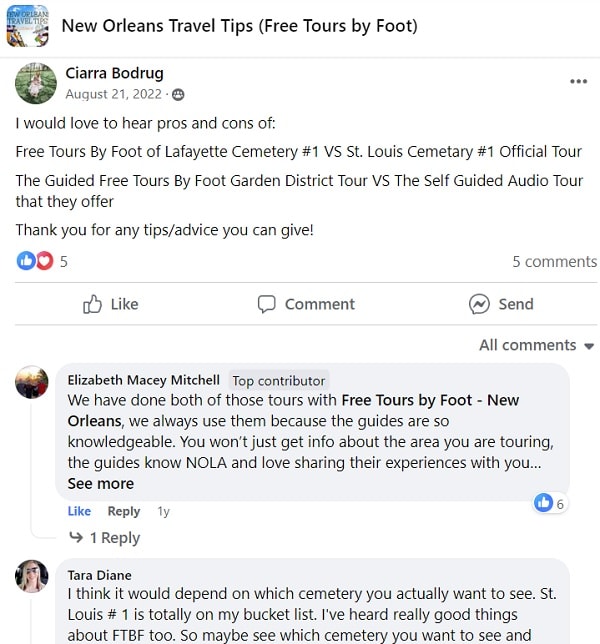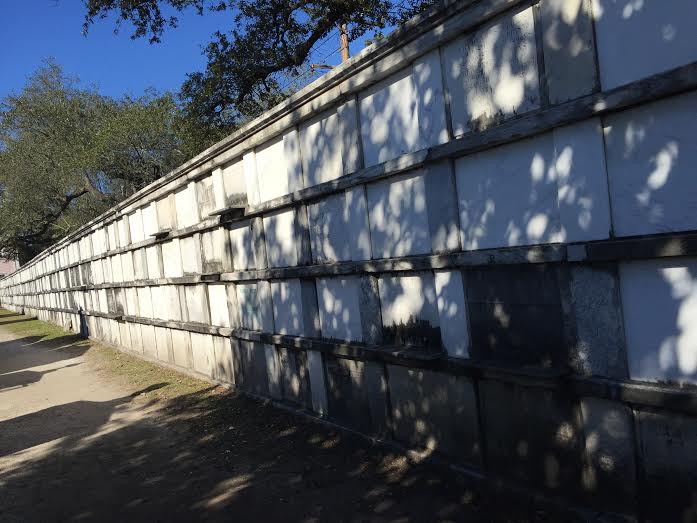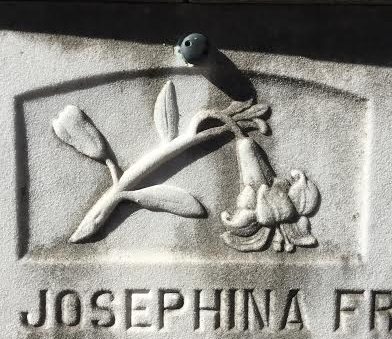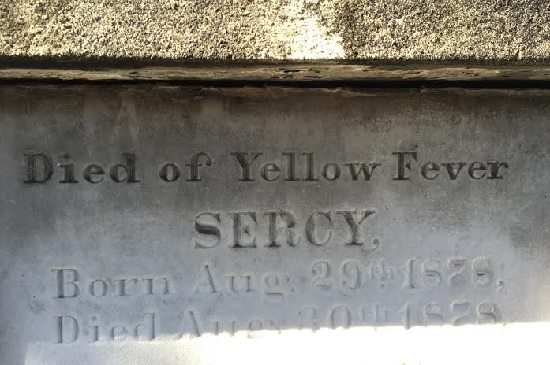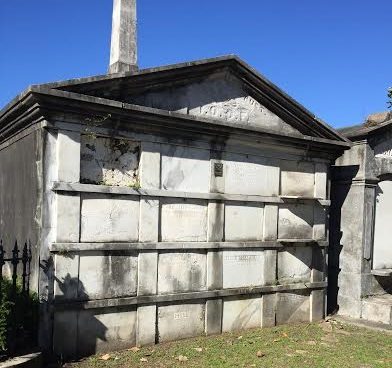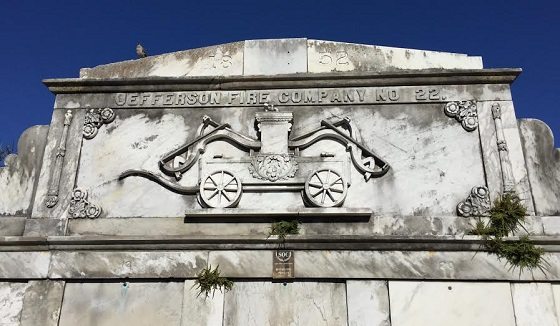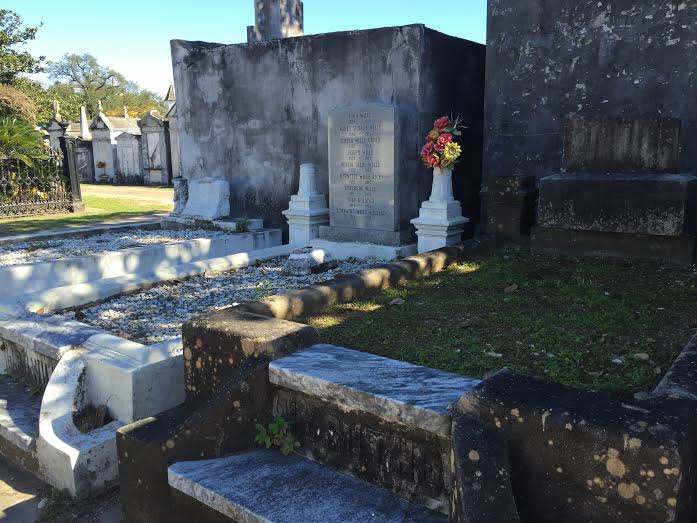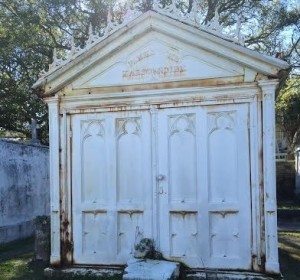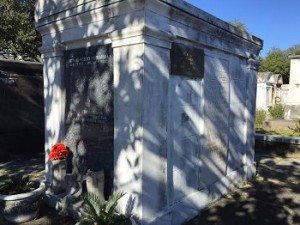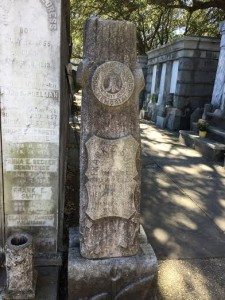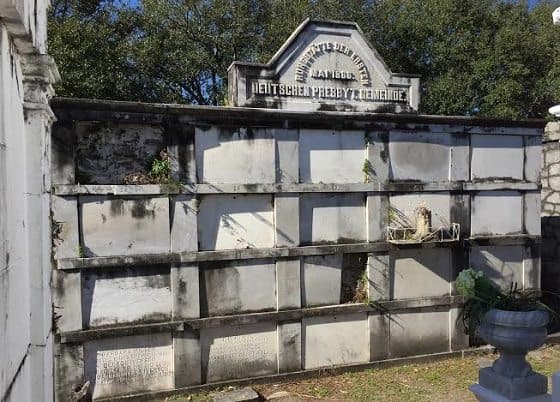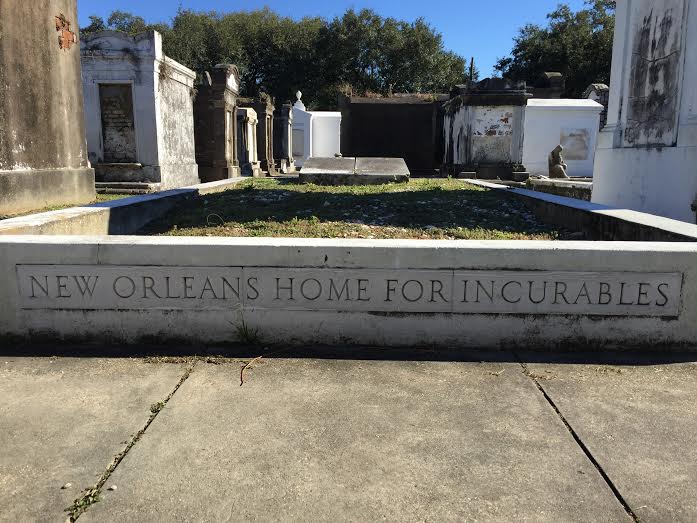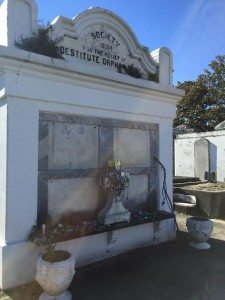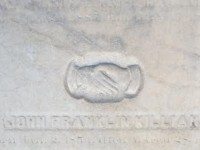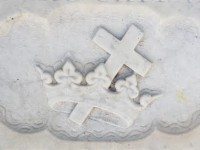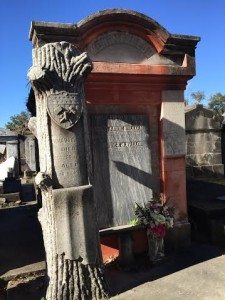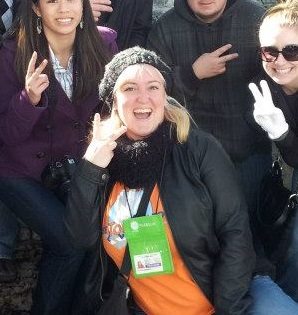This post is a guide to Lafayette Cemetery #1 in New Orleans' Garden District.
I include tips on how to get here, a self-guided tour, as well a brief history.
To write this post, I relied on the extensive experiences that I and my fellow local tour guides have of the cemetery.
We lead dozens of guided walking tours through the streets of Garden District and through the cemetery every week, guiding hundreds of visitors.
We know a thing or two about this place. We even wrote and published an audio tour of the area.
You can also take our GPS-enabled audio tour anytime the cemetery is open.
I also relied partially on the roughly 42k members of our New Orleans Travel Tips who have shared their experiences about visiting Lafayette Cemetery #1.
Our group is comprised of locals, like our tour guides, veteran visitors, as well as newbies to New Orleans.
You don't need to become a member in order to read the posts, comments, and recommendations.
- Directions
- History and Background
- Why Is It Closed?
- Tombs and Famous Graves
- Guided Tours
- Things to See in the Garden District
- Other Things to Do in NOLA
HOW TO GET HERE
Lafayette Cemetery #1 is located in the Garden District neighborhood of New Orleans, approximately 10-15 min south by car from the French Quarter (map).
Many visitors to New Orleans will elect to take the St. Charles Streetcar from Canal Street in the Quarter to the Garden District.
The streetcar stop is just a 3-minute walk to the entrance of the cemetery.

This Garden District gem has two entrances one on Washington Ave. and one on 6th Street.
It is an easy walk from the streetcar or the #11 Magazine Street bus on Washington Avenue to the bordering streets of Coliseum and Prytania.
Also, do note that several bus companies also visit the Lafayette Cemetery and the Garden District.
Do read our post on which New Orleans bus tours may be best for you.
Several also offer combo packages that offer discounts if you combine this with a swamp or plantation tour.
Hours - note that Lafayette Cemetery #1 is temporarily closed for repairs.
- Weekdays from 7 am - 3 pm
- Weekends from 8 am - 4 pm
LAFAYETTE CEMETERY HISTORY
Many people visit the oldest still-standing St. Louis Cemetery #1 and do not realize there are many other distinctive cemeteries that are worth visiting in New Orleans.
One of our favorites is Lafayette Cemetery #1.
The planning of this cemetery began in 1832 in preparation for the creation of the City of Lafayette.
The City of Lafayette would eventually become a part of the City of New Orleans and included what is known today as the Garden District.
It was laid out in a very formal manner with four quadrants.
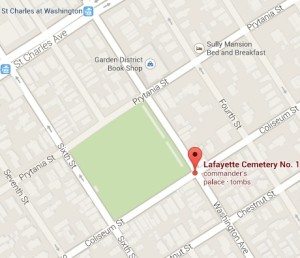
There are Magnolia trees for shade and an area for funeral processions in a cross shape, and there were originally very fragrant flowers abundant between the tombs.
The cemetery has been active since 1833 and still has burials occurring.
There are about 1,000 tombs and an estimated 7,000 people buried in Lafayette #1. It is a city block in size.
The cemetery is also not racially or religiously segregated and contains over 26 nationalities.
Notable tombs include the Jefferson Fire Co. #22's society tomb with an ornate fire pump adhered, an Odd Fellows tomb, and the metal tomb that inspired the author Anne Rice when writing the novel Interview with a Vampire.
The cemetery is also said to have inspired her novels on the Mayfair Witches.
The Open Koneig's tomb is a favorite for people to peek inside and see the inner workings of a tomb.
Lafayette #1 is also the most filmed cemetery in New Orleans.
Most recently scenes from The Originals on the CW Network, and NCIS: New Orleans have been filmed inside.
Tour participants have spotted Mark Ruffalo, Ryan Reynolds, and Samuel L. Jackson inside.
Additionally, the movie Double Jeopardy was filmed inside (see video below). Not to forget, tour guide Sarah’s favorite is the music video Right Stuff by the New Kids on the Block.
The cemetery is predominately filled with family tombs.
Save our Cemeteries, the non-profit responsible for most of the Preservation in the cemetery has done extensive tomb restoration beginning in 1979.
They plan to restore over 85 tombs in the cemetery in the next 5 years.
Why is Lafayette Cemetery No. 1 Closed?
During different periods of its history, the cemetery's maintenance has been neglected.
Repair work and maintenance were long overdue. Work has begun to level uneven walkways, repair tombs, and cut back overgrowth, including tree removal.
This work will include new ADA-compliant sidewalks, bathrooms, a cemetery sexton's cottage, as well as mandatory work on deteriorating tombs.
The city has estimated that the cemetery will reopen to the public in late 2024.
What Movies Were Filmed at Lafayette Cemetery?
Lafayette Cemetery #1 is the most filmed cemetery in the city. Chances are if you have seen a New Orleans Cemetery depicted in a Hollywood production it is Lafayette #1.
A few of these movie productions include; Hard Target (1993), Interview with a Vampire (1994), Double Jeopardy (1999), Dracula 2000 (2000), Deja Vu (2006), Jonah Hex (2010), and Black and Blue (2019).
Television shows have also used the cemetery as a location, including The Originals filmed down the center aisle, as well as Your Honor with Brian Cranston.
Two standouts that Millennials might find interesting are music videos filmed inside for New Kids On The Block and LeAnn Rimes.
If you see large white trucks parked along the perimeter of the cemetery it is likely a new production is in the works!
Famous People Buried in Lafayette Cemetery No. 1
Without a doubt, St. Louis #1 Cemetery has the most "famous" people interred inside.
The most famous inhabitants of Lafayette Cemetery are fictional.
Anne Rice has Lafayette #1 be the final resting place of several of her famous characters including the Mayfair Witches, and Lestat. The latter's tomb is made of metal and is quite unique.
However, some very historically notable people are buried here, including John Howard Ferguson Judge Ferguson of the Plessy vs. Ferguson “separate-but-equal” case.
Brigadier General Harry T. Hays who led the 1st Louisiana Brigade during the Civil War is also in the cemetery to the right of the Washington Avenue entrance.
SELF-GUIDED TOUR OF LAFAYETTE CEMETERY #1
Below is a short, self-guided tour of the cemetery. This tour should take you approximately 45-60 minutes depending on how quickly you walk.
However, make sure to be careful as the ground is over uneven.
Note that Lafayette Cemetery #1 is closed for repairs and will hopefully reopen in 2024.
We also offer a more detailed, GPS-enabled audio tour of Lafayette Cemetery. Below is a sample clip from this audio tour.
We also offer a daily tour of the Garden District that spends about 20-30 minutes in the cemetery.
The above short video tour was produced by NolaDeeJ who based his video on our self-guided tour below.
Entrance, Washington Avenue between Prytania and Coliseum
Notice the two live oak trees that flank the entrance to the Cemetery.
Two trees were planted there in the 1850s, but during Hurricane Katrina in 2005, the one on the riverside fell.
The small one on that spot was planted in 2009 to replace the lost tree.
When Double Jeopardy was filmed here in 1999, the producers replaced the “1” on the entrance gate with a “3”. There is no Lafayette Cemetery #3 – yet.
Go through the gates. Look to your right and left as you enter and notice the rows of wall vaults.
These are internment chambers, used as temporary resting places or a less costly alternative to building a large family tomb. There are 496 wall vaults in the cemetery.
On the third tomb on the right as you proceed down the center aisle, notice the broken flower engraving.
Broken flowers are a common funerary symbol, representing the end of life.
You will notice several designs of the broken flower image in the cemetery. When you see an engraving of a flower arrangement, look closely for the broken flower.
Continue down the aisle with two more tombs.
Sercy Tomb
The Sercy family lost three children in two days to yellow fever in 1878.
Yellow fever took the lives of tens of thousands of New Orleanians before it was discovered that it was spread by the Aedes aegypti mosquito.
Garden District residents thought they were protecting themselves from the dreaded disease with their gardens and houses spaced far apart.
But actually, they were creating mosquito breeding sites in their reflecting pools and cisterns.
Continue walking in the center aisle to the last three tombs before the main intersection.
Odd Fellows Tomb
A great example of a society tomb. Independent Order of Odd Fellows (IOOF) is a fraternal organization and benevolent society that is still active today.
The societies provided assistance and a social outlet to their members, who paid dues and upon their deaths were allowed to be interred in the society tomb.
Hagan and Henderson Tomb
This remarkably sturdy tomb was built by the man who rests in it.
James Hagan, a tomb builder, constructed his future resting place of Texas granite in 1870.
Jefferson Fire Company No. 22 Tomb
The largest of three volunteer fire company tombs in the cemetery, it boasts an impressive carved fire engine on the pediment.
Turn right after the Jefferson Fire Company tomb.
On the left, you will see a small “neighborhood” of low tombs with grass or rocks on top. This type of tomb is called a “coping tomb.”
Coping Tombs
If you wish to be buried in soil in New Orleans, this is how it will be done.
A coping wall is built, usually going about three feet underground, unembalmed bodies in unfinished pine boxes are placed inside, and dirt, brought in from outside the cemetery, is used to cover the casket.
In the 1800s, soil merchants sold dirt shipped in from around the world, so one could be buried in the soil of his or her home country or state.
Continue past the coping tombs and look for a white tomb with a cast-iron fence around it.
Moses-Payne Tomb
Jacob Payne was a Garden District resident in whose home Jefferson Davis, the President of the Confederacy, died.
The tomb displays a less common funerary symbol, the hourglass with wings.
This classic symbol represents the passage of time and the shortness of life. It is associated with Chronos, the ancient Greek personification of time.
Continue down the same aisle. At the end of the aisle, turn left. Keep going till you see an open tomb.
Koenig Tomb
There are no burials recorded for this tomb.
It is believed the Koenig family moved away before ever using the tomb, but they kindly left us with a chance to see how the tombs are constructed.
When a family member dies, the funeral director has the tomb opened and the remains of the previous occupant are removed, bagged, and placed in the chamber underneath.
The new occupant then moves into the chamber until it is needed again.
Continue down the same aisle till you get to the end, then turn left. You are now on the Sixth Street or “uptown” side of the cemetery.
There once was a wall of burial chambers on this side like the ones on the Washington Avenue side, but they were demolished in 1929.
Look for the Mallard tomb on your left, walk on the right side of the Mallard tomb, and go around to the front of the white cast iron tomb.
Karstendiek Tomb
This is the only cast-iron tomb in this cemetery.
It was the model for a prop tomb in the locally-filmed Interview with the Vampire in 1994.
Cast iron tombs were introduced to New Orleans by Wood and Miltenberger, a local distributor of the Philadelphia-based ironworks company Wood and Perot.
They were constructed of pre-fabricated pieces of cast iron.
Families could look at catalogs and assemble “customized” tombs from panels to be used as walls, and then pick embellishments to dress them up to their taste.
Since they were pre-fabricated, the tombs were considered to be of lesser quality than brick-and-mortar structures.
Also, they tended to rust in our humidity and required a different type of maintenance, despite the claim by the sellers that they were “designed…expressly for the South.”
Mr. Miltenberger, however, believed in his product, as he is interred in his own cast-iron tomb in the Greenwood Cemetery.
Wood and Miltenberger also sold the cornstalk fences visitors see on our tours of the Garden District and French Quarter.
Face the cast-iron tomb and turn left, then walk until you see a coping tomb on your left with a column (Sherrouse). The unbroken column usually indicated military service.
Turn left after this tomb. Continue until you see a white tomb on your left (Scott) and turn right. Two tombs down is the T.J. Earhart tomb.
Earhart/Ferguson Tomb
This is the final resting place of Judge John Howard Ferguson, of the landmark civil rights case, Plessy v. Ferguson (1896).
Judge Ferguson was a judge in the local criminal district court when he presided over a case in which a black man, Homer Plessy, was arrested after refusing to exit a whites-only rail car in New Orleans.
Judge Ferguson ruled that the Louisiana Railway Car Act of 1890, which declared that rail companies had to provide “separate but equal” accommodations for black and white passengers traveling within state lines, was constitutional.
Plessy appealed the case all the way to the United States Supreme Court, where he lost, and “separate but equal” was established as a precedent to be used over and over again across the country until it was overturned in Brown v. The Board of Education of Topeka in 1954.
Also of note on this tomb is the distinctive “no cross, no crown” image on the pediment.
This is a reference to the Christian belief that if one does not accept the burdens of life (“cross”), one will not be able to accept the rewards of Heaven (“crown”).
At this point, you will backtrack a little bit. Facing the Earhart tomb, turn right, and then turn left at the Marks tomb. Straight ahead, you will see a small open space.
This is the spot where a prop tomb was built for the 1999 movie Double Jeopardy.
The character portrayed by Ashley Judd was locked in this tomb and had to escape. Turn left at the empty space.
On the Warren tomb on the right, a statue of a young angel sits. Angels are commonly depicted in cemeteries, as protectors or as escorts to Heaven.
In order to be accurately depicted according to the custom, the angel must be sexless, beardless, winged, and human in form.
On the last tomb on the left before the intersection, you will notice engraved lists of names on all four sides.
Closure Tablets on Four Sides
The name for the marble or granite slab that usually covers the tomb openings and is engraved with names is closure tablet.
It is common to see closure tablets on more than one side of a tomb for several reasons.
The previous tablet could be full of names and a new one has to be started, the owner may wish to replace marble, which tends to deteriorate in our humidity, with granite, or the family may sell their tomb to another family.
When the latter situation occurs, it is the custom to move the previous owner’s tablet to the back or the side and start a new one on the front.
Now, walk across the aisle, along the right side of the tomb with the iron fence (Toledano). Continue until you have the Deering coping tomb in front of you, then turn right.
You will see the caretaker’s building in front of you. Turn left into the aisle. At this corner, you will see one of many Woodmen of the World tree stump markers.
Woodmen of the World
These interesting markers are all over the cemetery.
The Woodmen of the World was initially a fraternal benefit organization whose lodges sometimes did volunteer work in their communities.
Eventually, Woodmen evolved into an insurance provider.
One of the objectives of the lodges (and later the insurance company) was to provide an appropriate burial for all its members, which included a marker in the image of a tree stump.
Originally meant to be of a uniform design, stonecutters and masons began to incorporate their own flourishes into the basic type.
You are now back in the Sixth Street aisle. Turn left at the very next intersection, and walk around to the front of a raised graveyard.
McLellan-Fayesoux-Scudder Tombs
The focal point of this miniature raised graveyard is the broken column – a symbol of life being cut short.
This tomb is a memorial for the 22-year-old son of the McLellan family, who was killed in action in the American Civil War.
He was a Confederate soldier who died at the Battle of Richmond in 1862.
Several other members of the family are buried at the site, and the small enclosure in front of it is owned by the family as well and was used for All Saints Day celebrations.
All Saints Day, November 1st, was traditionally a day when people would go to cemeteries and tend to the graves of loved ones.
In typical New Orleans style, it became a day of celebration, with music and food vendors, families picnicking and visiting, children playing among the tombs, and nuns collecting donations for various charities.
Looking at the McLellan broken column, turn left and walk straight ahead. Notice the broken-winged angel on your left. It is holding an upside-down torch.
The torch is an ancient symbol of life, and the upside-down torch is a sad symbol for the end of life.
At the end of this aisle is a little-enclosed grove with four tombs.
The Secret Garden
Four childhood friends – Dupuy, Ginder, Palfrey, and Griswold – formed a secret club they called the “Quarto.”
As adults, they would have secret meetings and, it is speculated, perform anonymous acts of generosity for people in need.
No one can verify this, however, because the last surviving member of this group burned their meeting notes.
The members of the Quarto, wishing to remain together for eternity, purchased the land at the corner of the cemetery and built their tombs together.
The secret garden was ahead and on your right as you came to the end of the aisle, and you will turn left (the first tomb on your right will be August E. J. Egdorf).
Go straight, and then turn left at the next intersection (James Prest). As you go down this aisle, you will see a society tomb on the left.
Deutschen Presbyterian Gemeinde Tomb
This is one of many German society tombs in New Orleans. The German influence on New Orleans’ culture is immeasurable.
German men were the builders of the glorious Garden District mansions that still stand today.
They were the gardeners that gave the district its reputation as well as the butchers, draymen, and bakers.
New Orleans would not be the same without Hubig’s pies, Leidenheimer bread, and Haydel’s king cakes.
Continue past the Deutschen tomb. When you are walking right into the back of a tomb, turn right.
You will see a gated tomb on your left. There are two interesting funerary symbols in this area.
Vessel with Flame and Weeping Woman
There is an iron vessel with a flame on it in the gate around the tomb.
This is a popular funerary symbol, meant to represent the eternal flame or the eternal spirit of man.
Across from the tomb, notice the statue of the woman on the ground. She is barefoot, weeping, and holding an urn.
The weeping woman is a common funerary symbol, representing maternal love and grief and sorrow.
Her bare feet represent humility and her powerlessness over the inevitability of death.
The urn, a repository for ashes of the deceased since ancient times, has been used as a symbol of the death of the earthly body and its eventual return to dust.
Although cremation was not common in New Orleans until modern times (and not even an option for Catholics until 1963), symbolic urns can be found on some of the oldest tombs in the city.
Turn away from the weeping woman and walk with the gate on your left, then take your first right.
You will find yourself in front of a very large coping tomb.
New Orleans Home for Incurables Tomb
The New Orleans Home for Incurables was chartered in 1891 with an all-female board of directors to provide a place of refuge and comfort to people with severe mental or physical deformities or diseases that were considered hopeless and beyond help.
Often, these people of all ages, genders, and races were abandoned and forgotten by their families because their conditions caused embarrassment.
Here, they are laid to rest in a large society tomb in the coping tomb style.
Face the Incurables tomb and turn left. Walk straight ahead. As you continue down the aisle, you will see several coping tombs in need of attention on your left.
You will approach the back of a large white tomb. Go around to the front. It is the tomb of the Destitute Orphan Boys.
Society for the Relief of Destitute Orphan Boys Tomb
This society, formed during the years of devastating epidemics of tropical diseases such as yellow fever and malaria, still exists today as the Waldo Burton Memorial Home.
Visitors like to leave offerings and trinkets here.
If anything that would be enjoyed by a modern boy is left – like trucks, cars, or stuffed animals – a representative from Waldo Burton will bring it to the home, which provides care and services for boys ages 6-17.
Face the boys’ tomb, then turn left, and continue all the way down the magnolia-shaded aisle.
On the left, at the Koester tomb, you will see a little lamb on top of the pediment.
The lamb is a symbol of Christ in his sacrificial role and embodies the virtues of innocence and gentleness. It is often used on the graves of children.
Walk past a few more tombs and look for the Bauvais tomb on your left.
There is an engraving of two hands clasped. This is a symbol of holy matrimony and inseparability even after death.
The next tomb, also belonging to the Bauvais family, depicts a cross and crown in a cloud.
This is a symbol of God’s kingly office and the promise of eternal life in Heaven.
When you get to the end of the aisle, turn left at the sign that reads, “Square 2 Laurel Walk.” On your left, you will see a red tomb.
Henry Fallon Tomb
Although it is fading, you can see how this tomb was once a brilliant color.
In fact, many of the tombs in all the city’s cemeteries were bright green, mustard, rust, and turquoise.
The family considered it a matter of honor to care for the family tomb and would add natural pigments to limewash to paint the tombs.
Facing the red tomb, turn right, and continue the way you have been going. You will see a rare example of an in-ground burial on the right.
Past some coping tombs, you will see a tall family crypt with the name Sarah E. Hester at the top.
Hester/Short Tomb
Sarah Hester was the mother of Henry Hester, the superintendent of the New Orleans Cotton Exchange for 61 years.
Col. Robert Short was the owner of “Colonel Short’s Villa,” the lovely mansion at the corner of Prytania and Fourth that is a popular stop on walking tours.
When you get to the end of the aisle, turn left at “Willow Walk.” There will now be a row of wall vaults on your right.
These particular vaults on the downtown river side of the cemetery were struck by lightning in 1990, exposing the contents of 56 tombs.
Turn left at the last intersection before the place where you entered the cemetery. Walk down a bit.
On your right, you will see a tomb covered with an overgrowth of plants enclosed by an iron gate. Right past it is a tall white tomb with many plaques and tablets.
Smith-Dumestre Tomb
This is the tomb with the most names on it in Lafayette Cemetery #1. It has 37 names, and the family claims to have ten more awaiting inscriptions.
Turn back to go the way you just came, make a left after the gate of the overgrown tomb, and then a right to exit.





